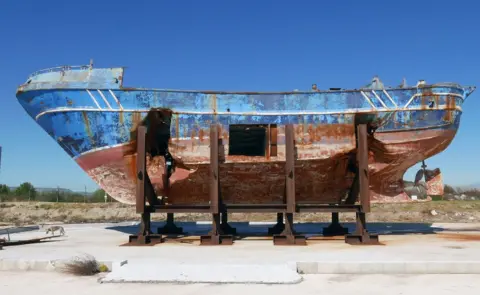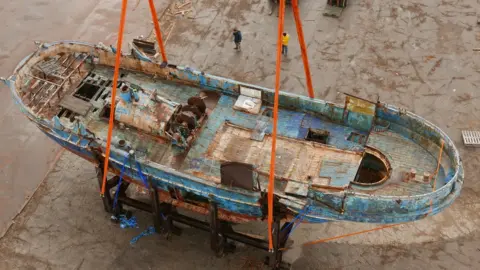Venice Biennale: Is exhibiting tragic migrant ship distasteful?
 Barca Nostra
Barca NostraIf the purpose of art is to elicit a strong reaction then exhibiting a shipwreck at one of the world's biggest art exhibitions has passed the test.
But has it overstepped the boundaries of taste?
Critics have hit out at the use of the hull of the ship, in which hundreds of migrants drowned, at the Venice Biennale.
The fishing vessel sank on its trip from Libya to Italy in 2015 and at least 700 people, many from Africa, died as a result.
Swiss-Icelandic artist Christoph Büchel brought the boat to the Biennale which opened to the public at the weekend.
He said that his exhibit, Barca Nostra (Our Boat), was intended to be "a monument to contemporary migration".
It was the Mediterranean's deadliest shipwreck in living memory and happened in the middle of the European migrant crisis, which peaked in 2016 with an estimated 5,096 people dying or going missing trying to cross the Mediterranean - the highest number ever recorded.
Some art critics have been scathing in their attacks on Büchel's use of the ship.
In the Guardian, Adrian Searle calls it a vulgar gesture.
"I found Büchel's appropriation of the boat in which so many migrants lost their lives a vile and mawkish spectacle in the context of the Biennale.
"The best one can say of Büchel's intervention is that it brings us face to face with death. Biennale visitors pause to take selfies in front of it."
 Barca Nostra
Barca NostraHow people interact with the boat has appeared to alarm observers.
A tweet showing a cafe next to the boat is described as "peak art world" by Martin Herbert.
Allow X content?
Matthew Mpoke Bigg from the UN refugee agency points out that people were "sipping aperitifs at a nearby cafe in the sunshine, some apparently ignorant of the horror of what happened there".
Calling it the "most troubling" exhibit at the Biennale, Cristina Ruiz in the Art Newspaper gives an explanation why art lovers may not be acting in the sombre way some might expect.
"Art can and should deal with the most pressing issues of our time and Büchel's boat would easily be the most important inclusion in [the] Biennale if it were not for the fact that Büchel has chosen to provide no labels or signs near the rusting vessel.
"It is true that there is information about the boat and its history in the Biennale catalogue but only a small proportion of visitors purchase this.
"So many, if not most, exhibition goers will eat and drink in the shadow of this ship with absolutely no idea of the tragedy that unfolded there."

Who died in the 18 April 2015 shipwreck?
- Migrants from around 20 countries are believed to have been on the boat
- Countries of origin stretched from Bangladesh to Mauritania
- Many came from Africa's Sahel region
- They are believed to have hitched rides in trucks to get to the Libyan coast
- As of December 2018, investigators had not yet been able to formally identify even one of the dead
- Among the dead was a boy who had sewn a bag containing dirt from his homeland, Eritrea, into his jacket
- Korans, Buddhist rosaries, and an Orthodox cross were also found

Context is everything, it seems for these critics.
One detail of context to be considered is the motivation of the curator of the Venice Biennale, explains BBC arts editor Will Gompertz.
He points out that curator Ralph Rugoff had already said art should be "entertaining".
Allow X content?
But the critics went further, starting to question the purpose of art in our society at this point.
"Horrified" by the exhibit, Stephen Pritchard wrote in his blog Colouring in Culture that the artist was exploiting the tragedy:
"To see the art world fawn over a shipwreck that was a grave to so many people is utterly abhorrent.
"To exhibit it as a 'relic' or 'monument' such a tragic loss of life is to reify, commodify and totally exploit the lives of not only those who lost their lives but migration itself."
'Barbarous exhibit'
While Yasmin Alibhai-Brown says in the I newspaper that the exhibit is reflective of a worrying trend in the art world - an exhibit that "lacks integrity".
"Büchel simply used the dispossessed on the high seas to flaunt his artistic and political nihilism".
For her, it was not the people taking selfies and having picnics next to the tragic artefact that stood out.
Instead, it was what was not there that led her to conclude the exhibit was "barbarous":
"The dead souls are not there, not even as black silhouettes. They are, one surmises, unimportant to the 'provocative' Swiss-Icelandic artist, Christopher Büchel".
Büchel himself declined to comment when contacted by the BBC.
Instead he said everything he wanted to say was in the original press release.
In this he argues that Barca Nostra is "a relic of a human tragedy but also a monument to contemporary migration".
"The vessel has become a symbolic object, dedicated not only to the victims of the tragic event in 2015 and the people involved in its recovery, but to our mutual responsibility representing the collective policies and politics that create such wrecks."
